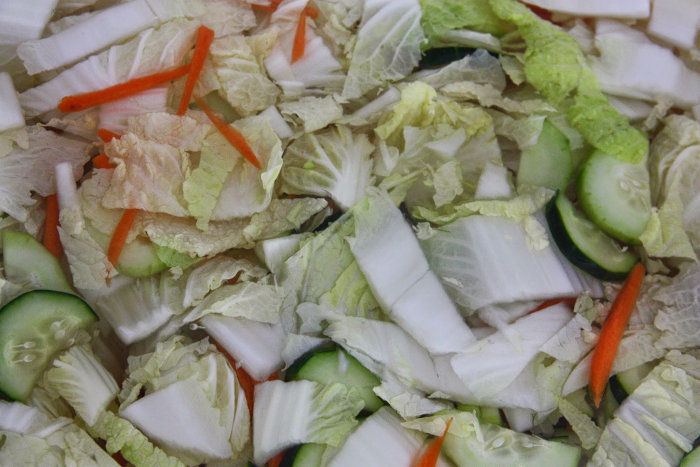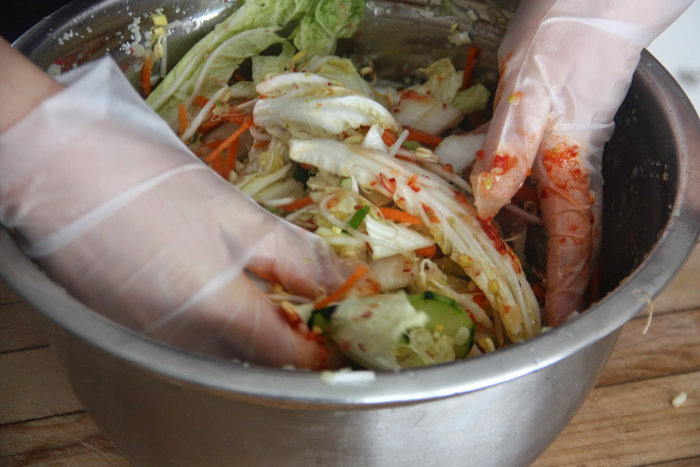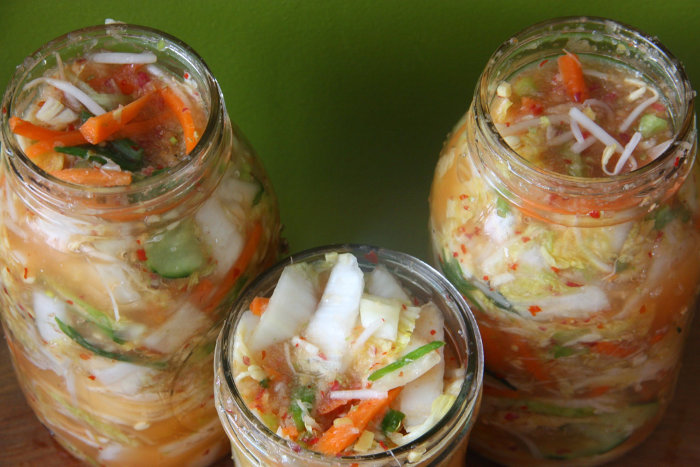 Why do Koreans eat over 40 pounds of kimchi every year (each!)? What makes this national dish, and hallmark of Korean culture, so special?
Why do Koreans eat over 40 pounds of kimchi every year (each!)? What makes this national dish, and hallmark of Korean culture, so special?
When you discover the health benefits of this amazing dish, all will become clear…!
Quiz: Is Your Body TOXIC? Take the Test...
(get your free personalized report)
Enjoyed for over 2000 Years!
Koreans say ”kimchi” when taking photos, in the same way we say “cheese”!
This shows how big a part of Korean culture kimchi is: they even have a special day dedicated to it!
Elder women spend months preparing for KimJang, a celebration of kimchi. They grow “Korean paechu” cabbages (these are similar to a napa cabbage in America) and make homemade chili paste using pulverized Korean chili peppers which are dried months in advance.
When the process is ready to start, a labor of love begins that will last a number of days (& many nights!). The cabbages are cut, soaked, rinsed, rubbed with the delicate chilis and spices, & then stored to ferment.
It’s a fun, social event with women from the whole neighborhood involved! The process is beautiful and a time-honored tradition.
Quiz: Is Your Body TOXIC? Take the Test...
(personalized report)
Fountain of Youth?
 Kimchi is to Koreans as ketchup is to Americans (but much healthier!), and can be used as a condiment, an enhancer, or a main dish – but preferably a side salad.
Kimchi is to Koreans as ketchup is to Americans (but much healthier!), and can be used as a condiment, an enhancer, or a main dish – but preferably a side salad.
It’s one of the healthiest fermented foods, with over 130 studies uncovering its health benefits. Kimchi is loaded with vitamins A, B, C (& sometimes vitamin K), but perhaps more importantly it is packed with healthy bacteria which help to create a healthy gut & well-functioning digestive system (see health benefits below).
Many traditional and alternative health practitioners, including Dr Mercola and Weston A. Price, now believe we should be eating kimchi (or other fermented foods) on a daily basis.
- Great source of probiotics / beneficial bacteria
- Better moods
- Improved digestion
- Better gut health
- Improved absorption of nutrients from food
- Preventive medicine for yeast infections
- More frequent and easier bathroom visits
- Supports a strong immune system
What is Kimchi?

Still unsure of what kimchi is? Here’s a simple definition: It’s a fermented food made with cabbage, diakon (radish), garlic, and onions.
The cabbage is soaked in salt water, rinsed, and then hot chili paste is spread on the leaves. These ingredients are combined with seasonings such as: brine (vinegar), garlic, radishes, scallions, ginger, salted shrimp, and anchovy paste. It’s then left for the first couple of days at room temperature, and for up to 2 weeks in a cool dark place to ferment.
You may have heard of kimchi being buried in the dirt? This was the traditional way to make kimchi using earthenware jars which were buried underground. Now all you need are glass containers and a dark place to help the fermentation process.
Packed with Probiotics
When kimchi is ready, it will have been through a process of lacto-fermentation, which not only helps to preserve the food but also enhances the digestibility and nutritional value of the vegetables. Perhaps most importantly, the fermentation process turns basic ingredients into a potent probiotic supplement, packed full of healthy bacteria to populate your gut.

Whilst the fermentation process may seem mysterious, it is actually very scientific. To summarize the work by Dr. Weston A. Price, when vegetables and fruit are paired together, submerged in water, and sealed with salt, a wonderful process happens and lactic acid is made. This is when a group of bacteria known as lactobacilli are called out to perform their duties and start the fermentation process, which creates an abundance of healthy, gut healing bacteria.
Fermented foods are not a new concept in the world – just new to the western world. Every traditional culture has made and perfected their type of fermented foods, and they are known to have been used for at least the last 7000 years (probably more).
Fermented foods are currently experiencing a resurgence as people finally discover the amazing health benefits of these amazing foods (which are actually very easy to make). When you look at the increasing number of research studies touting the incredible benefits of fermented foods, you’ll probably want to include them as part of your daily diet, even if you’ve been put off in the past by their strong flavor.
The gut is considered by most doctors and scientists to be the second brain. It controls your mood, emotions, physical activity, and sex life. When it’s healthy and flourishing (with the proper balance of bacteria and enzymes) your “gut flora” will be happy, and everything in your life will reflect this.
Digestion and Immune System:
Did you know that up to 70% of the immune system comes from the digestive system? When treated properly, good digestion will flow, food will be absorbed more easily, and your body will be able to fully process the vitamins and minerals in your food (& send it to the areas of your body which need it most).
Absorption of Vitamins and Minerals:
We all want to get the most out of our foods. Fermented foods not only help to give foods higher levels of certain vitamins and minerals, but they can also improve the speed and efficiency of nutrient absorption, and may help to heal a leaky gut.
Think Go Pro (biotics… that is):
The same bacteria produced in many fermented foods, ‘Lactobacillus’, is also added to most probiotic supplements in health food stores. It has been well documented that probiotics can help with restoring the gut and regaining balance after illness or antibiotic usage. Why not go get your probiotics as nature intended, rather than taking another supplement?
Buy or Make Your Own?
Be careful when buying fermented foods. They are all not created equal, so read the labels and make conscious choices. Most store-bought brands are laced with sugars and/or preservatives. If you want to start slow, go to the deli section of your supermarket and look for the fresh pickles made in-house (Kefir is also easy to make by purchasing a Kefir starter kit, with whole or raw milk as the base).
Kimchi is best to make at home – see how easy it is to get started by using the recipe below…

Level: Novice, Easy, Beginner
(Makes 2 ½ qts)
Ingredients
 1 Head of Napa Cabbage (1-3 pounds)
1 Head of Napa Cabbage (1-3 pounds)- 3 Large Carrots
- 1 Cucumber
- 4 Scallions
- 2 Tbsp. or 2 small pieces Ginger
- 4 Tbsp. or 6-8 Cloves of Garlic
- 7 oz. Mung Beans
- ½ Apple
- ½ Pear
- ½ small Yellow Onion
- 3 oz. Fish Sauce
- ¼ cup Apple Cider Vinegar
- ¼ cup Korean Red Chili Sauce
Method:
1) Roughly chop the Napa cabbage, peel and julienne carrots, and peel and slice the cucumbers into halves.

2) Place into a large cambro and salt liberally.
3) Let the vegetables sit overnight to release as much water as possible.
4) Soak cabbage, carrot, and cucumber in a water bath and strain.
5) Spin the mixture in the salad spinner to get as much water off as possible. This is your base for the kimchi.
6) Peel and mince garlic and ginger. Slice scallion tops into one inch batons, and slice the remainder into ¼ inch rounds.

7) Toss ginger, garlic, scallion, and mung bean sprouts into the vegetable base.
8) In a blender, add pear, apple, onion, fish sauce, and apple cider vinegar and blend until frothy. Add this mixture to the vegetable base.

9) Mix Korean chili flake with water until it forms a smooth paste and add to the vegetable base.
10) Toss all your ingredients together until everything is evenly dispersed.

11) Place into a 2-3 quart containers, label with the date you started, put the lid on tight, and let sit at room temperature for 3 days.

12) Move to the refrigerator and let it sit there for 2 weeks before serving.
13) Enjoy!
Have you made kimchi before? Are you going to give it a try this week? Let us know your thoughts, and any questions in the comments below…
